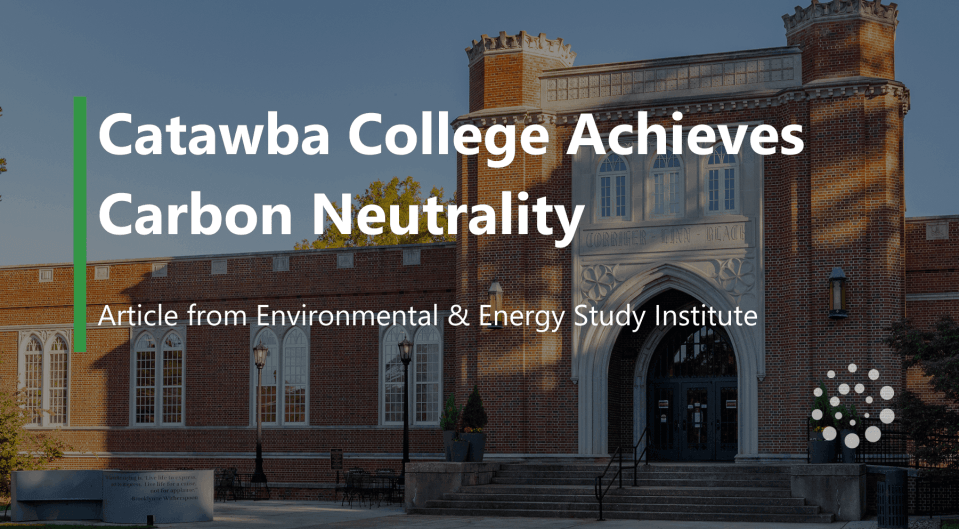This article was originally published on Environmental and Energy Study Institute.
Catawba College, established in 1851 in Salisbury, North Carolina, is the first college in the Southeast and the 13th in the country to achieve carbon neutrality, seven years ahead of its 2030 goal. In partnership with CMTA, Catawba College’s sustainability enhancements are able to offset the emissions from the fossil fuels burned on campus by producing on-site renewable energy, improve the efficiency of building operations, and allow the college to purchase carbon offsetting credits. The goal for CMTA and Catawba College is to eventually eliminate all fossil fuel consumption within the campus—a concerted effort involving all parts of the college community.
By purchasing carbon offsetting credits, the college fills the gap between on-site renewable energy production and the total energy consumption needed to power and heat its buildings. The college is working hard to close that gap completely by meeting 100% of its building and campus transportation energy needs with renewable energy.
In the 1990s, Catawba started installing a geothermal energy system to reduce its fossil fuel usage. Then, as the price of solar panels decreased, the college installed almost one megawatt of solar energy across 10 sites. Since 2014, the college has installed more than 3,044 solar panels, taking advantage of nine buildings' flat roofs and the need to resurface them.
The solar panels are expected to save the college about $5 million over the next 20 years and reduce the campus’s annual carbon emissions by 1,050 metric tons, equivalent to taking 193 vehicles off the road each year. Since their installation, the solar panels have generated about 7 million kilowatt-hours of locally produced clean energy, offsetting the need to buy power from the fossil fuel-based power grid.
Installing Ground-Source Heat Pumps
Catawba’s next big project involves installing ground-source heat pumps to provide renewable heating and cooling options for several on-campus buildings, including the library and chapel. The library is already benefiting from geothermal energy, and the chapel will soon follow. About 39 wells, each 600 feet deep, have already been drilled across the one-and-a-half-acre field. After construction, the lawn will return to its original state, just in time for the fall semester.
When completed, the geothermal system will eliminate the need for about 265 million British thermal units of natural gas and reduce electricity consumption by 145,724 kWh, translating to 51 fewer metric tons of carbon emissions per year. Built with scalability in mind, the geothermal field now connects to a ground-source heat pump in the library and will soon connect to the chapel as well. Once a heat pump is installed and connected to the closed-loop coolant system, the old fossil-fuel-powered furnaces can be removed, which reduces fossil fuel usage and greenhouse gas emissions.
The passage of the Inflation Reduction Act of 2022 (IRA) (P.L. 117-169) and its direct pay for nonprofits and tax-exempt entities provisions will greatly help the college pay for the geothermal system. As a nonprofit, Catawba College can claim 30% of the total costs of installing ground-source heat pumps. Using direct pay or elective pay, the college can monetize these federal clean energy tax credits even though it does not pay taxes. Once the heat pumps are put into service in fall 2024, Catawba College can pre-register for direct pay and claim the tax incentives when they file their tax return in 2025.
Before the IRA and direct pay, Catawba College had to jump through complicated hoops to receive tax credits as a tax-exempt organization when it installed solar panels throughout the college.
Future Planning and Next Steps
After the heat pumps are fully installed, the next step is to eliminate all remaining carbon emissions by displacing all fossil fuels currently being burned on campus. To do this, the college is replacing all fossil-fueled powered clothes dryers on campus with electric ones. Additionally, the school is installing tables with solar canopies for students to power laptops and cell phones while studying or eating lunch. Catawba College is also investing in transportation electrification by electrifying public safety cars, vans, and carts on campus.
The college also plans to install electric charging stations to help power all these electric vehicles. To reduce carbon emissions holistically, food from Catawba’s cafeterias is composted, preventing the leftover food from going to landfills where it would emit methane, a leading greenhouse gas, while decomposing.
“Catawba's master campus plan has even more sustainability and carbon reduction measures,” said Jared R. Tice, the college’s senior vice president and chief strategy officer. “We are looking 10-20 years into the future and see opportunities for major energy efficiency improvements through an integrative system approach to sustainability design from the start of each renovated residence hall, student space, and academic building. As we consider any new building or structure, sustainability will be at the forefront of our design work, including more carport solar over parking lots and rooftop solar on buildings, and plans for a massive geothermal well field under the athletic practice fields more than 10 times the size of the well field in front of the Omwake-Dearborn Chapel.”
